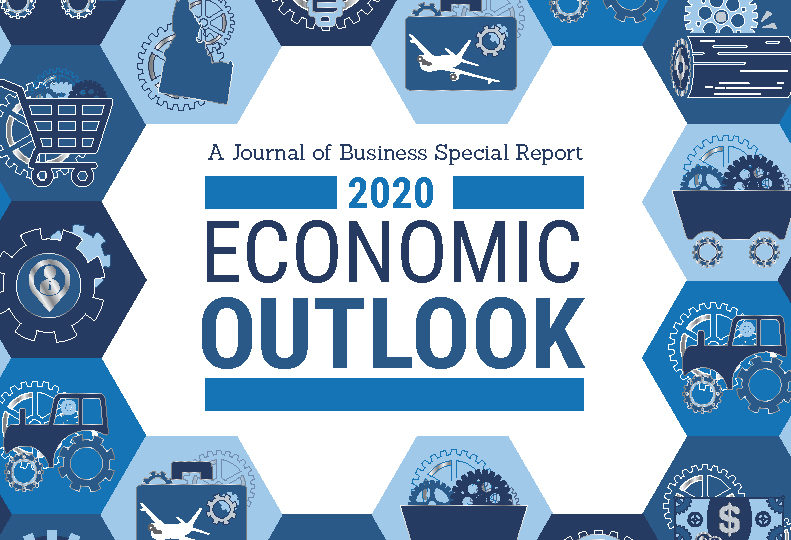
Home » 2020 Economic Outlook: Long economic roll could start to slow
2020 Economic Outlook: Long economic roll could start to slow
~

December 19, 2019
 Although the current decade of economic expansion still appears to have some momentum rolling into 2020, prognosticators here are expecting a slowdown in growth in major economic sectors.
Although the current decade of economic expansion still appears to have some momentum rolling into 2020, prognosticators here are expecting a slowdown in growth in major economic sectors.
Spokane-area economists are projecting up to 1.5% growth in jobs in the Spokane Metropolitan Statistical Area next year, although one analyst says Kootenai County job growth could reach 2% despite a tight labor market.
With two medical schools in Spokane, the health care education sector is adding good paying jobs.
The Amazon.com Inc. fulfillment center, which is expected to open this year and have 1,500 employees, also likely will spur growth.
Construction industry observers say that 2020 will be a strong year for the industry despite an expected modest cooldown.
Several school, road, and public works projects are in the construction pipeline, and warehouse and manufacturing sectors will be bolstered by economic development efforts on the West Plains and in Spokane Valley.
Some transportation projects likely will be delayed while legal questions surrounding Initiative 976 are resolved, including street maintenance projects funded through the city’s car tab fees.
Some headwinds for the construction industry include a shortage of trade workers and increasing material costs.
Single-family home sales are expected to slow down some – mostly due to lack homes for sale rather than a decline in demand, meaning that home prices likely will continue to increase.
Lack of inventory and rising prices for existing homes could bode well for housing construction.
Some brokers are expecting 2020 to be a bullish year for commercial real estate activity, especially in regard to companies needing smaller spaces.
While some market observers are predicting retail sales growth in the mid-single digits in the coming year, one local economic analyst says ongoing trade disputes with China could slow that growth.
Meantime, consumer confidence and wage growth are propping up household consumption of goods and services, but that could be problematic for the local economy if the buttress of confidence weakens.
A trend to watch in health care is the industry movement toward neighborhood clinics, including by large provider networks Providence St. Joseph Health and MultiCare Health Systems.
At the hospital level, MultiCare is expanding its Pulse Heart Institute Services at MultiCare Deaconess, and Providence also will focus on advancing cardiac care at its Providence Spokane Heart Institute, which is providing new diagnostic testing and surgical techniques.
Coeur d’Alene-based network Kootenai Health expects it will continue to exceed its growth and budget targets in 2020, while serving a growing number of patients from outside Kootenai County.
Tourism is yet another industry that’s expected to continue to grow here, but perhaps at a slower pace than in recent years.
The lodging sector, which is coming off a strong year, is seeing a lot of convention and group bookings in the coming year, especially in the summer months.
Spokane will host 65 sporting events with an expected economic impact to the community of $65 million.
The coming year should be positive for companies advancing what’s called exponential technologies that have the potential to increase capability or performance quickly, including Continuous Composites, of Coeur d’Alene; Selkirk Pharma Inc., coming to the West Plains; and Spokane Valley-based Stay Alfred.
Information technology is growing as an occupation faster than the rate of overall job growth. The challenge, however, will be in finding enough high-level engineers to feed job growth.
Looking to the regional agriculture sector, the U.S.-Japan Trade Agreement ratified earlier this month bodes well for wheat farmers, as the agreement includes a significant reduction of tariffs on wheat and barley. Japan could rise back to the top of Washington’s wheat export list.
The mining outlook is positive for some, but not all, mining interests based in the Inland Northwest.
Production is expected to ramp up in 2020 at the Lucky Friday mine near Mullan, Idaho, as Coeur d’Alene-based Hecla Mining Co. has announced it intends to replace striking miners with hourly workers.
Housing construction remains the major driver of lumber demand, which is expected to remain stable in the coming year. Lumber prices also are expected to remain steady, despite potential supply issues due to reduced production capacity in the Pacific Northwest and British Columbia.
Latest News
Related Articles





